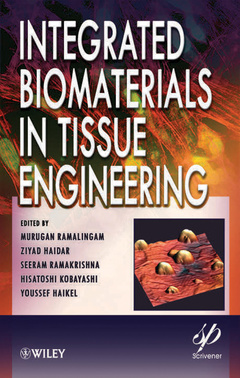Integrated Biomaterials in Tissue Engineering Biomedical Science, Engineering, and Technology Series
Coordonnateurs : Ramalingam Murugan, Haidar Ziyad, Ramakrishna Seeram, Kobayashi Hisatoshi, Haikel Youssef

This book acts as a self-contained resource for understanding the current technological advancement of biomaterials towards tissue engineering applications. It covers impact of biomaterials at different length scales such as macro/micro/nano/ level and offers extensive discussion on cell-biomaterial interactions with illustrative examples.
This resource offer a multi-disciplinary approach for the adaptability of integrated biomaterials in tissue repair and reconstruction.
1. Protocols for Biomaterial Scaffold Fabrication 1
Azadeh Seidi and Murugan Ramalingam
1.1 Introduction 1
1.2 Scaffolding Materials 4
1.3 Techniques for Biomaterial Scaffolds Fabrication 7
1.4 Summary 19
Acknowledgements 20
2. Ceramic Scaffolds, Current Issues and Future Trends 25
Seyed-Iman Roohani-Esfahani S. I. and Hala Zreiqat H.
2.1 Introduction 25
2.2 Essential Properties and Current Problems of Ceramic Scaffolds 27
2.3 Approaches to Overcome Ceramic Scaffolds Issues for the Next Generation of Scaffolds 30
2.4 Silk – a Bioactive Material 35
Acknowledgements 36
References 36
3. Preparation of Porous Scaffolds from Ice Particulate Templates for Tissue Engineering 47
Guoping Chen and Naoki Kawazoe
3.1 Introduction 48
3.2 Preparation of Porous Scaffolds Using Ice Particulates as Porogens 48
3.3 Preparation of Funnel-like Porous Scaffolds Using Embossed Ice Particulate Templates 51
3.4 Application of Funnel-like Porous Scaffolds in Three-dimensional Cell Culture 56
3.5 Application of Funnel-like Collagen Sponges in Cartilage Tissue Engineering 57
3.6 Summary 60
References 60
4. Fabrication of Tissue Engineering Scaffolds 63
Naznin Sultana and Min Wang
4.1 Introduction 64
4.2 Materials for Tissue Engineering Scaffolds 65
4.3 Fabrication Techniques for Tissue Engineering Scaffolds 68
4.4 Fabrication of Pure Polymer Scaffolds via Emulsion Freezing/Freeze-drying and Characteristics of the Scaffolds 70
4.5 Fabrication of Polymer Blend Scaffolds via Emulsion Freezing/Freeze-drying and Characteristics of the Scaffolds 78
4.6 Fabrication of Nanocomposite Scaffolds via Emulsion Freezing/Freeze-drying and Characteristics of the Scaffolds 80
4.7 Surface Modification for PHBV-based Scaffolds 85
4.8 Concluding Remarks 87
Acknowledgments 87
References 88
5. Electrospun Nanofiber and Stem Cells in Tissue Engineering 91
Susan Liao, Seeram Ramakrishna and Murugan Ramalingam
5.1 Introduction 92
5.2 Biodegradable Materials for Tissue Engineering 93
5.3 Nanofibrous Scaffolds 97
5.4 Stem Cells: A Potential Tool for Tissue Engineering 109
5.5 Prospects 114
Acknowledgement 116
References 116
6. Materials at the Interface Tissue-implant 121
Antonio Peramo
6.1 Introduction 122
6.2 Description of the Tissue-device Interface 123
6.3 Expected Function of the Materials at the Interface and their Evaluation and Selection 125
6.4 Experimental Techniques for the Tissue-implant Interface 132
6.5 Conclusion 135
References 135
7. Mesenchymal Stem Cells in Tissue Regeneration 139
Kalpana S. Katti, Avinash A. Ambre, and Dinesh R. Katti
7.1 Introduction 139
7.2 Mesenchymal stem cells (MSCs) 144
7.3 Understanding the Mesenchymal Stem Cells (MSCs) 149
7.4 Mesenchymal Stem Cell (MSC) Culture 152
7.5 Characterization of MSCs 155
7.6 MSCs in Bone Remodeling, Fracture Repair and their Use in Bone Tissue Engineering Applications 158
7.7 Influence of External Stimuli on MSC Behavior 159
7.8 Perspectives on Future of hMSCs in Tissue Engineering 161
References 162
8. Endochondral Bone Tissue Engineering 167
Sanne K. Both, Fang Yang, and John A. Jansen
8.1 Introduction 167
8.2 Tissue Engineering and Stem Cells 171
8.3 Scaffolds 175
8.4 Summary 181
References 182
9. Principles, Applications, and Technology of Craniofacial Bone Engineering 185
Mona K. Marei, Mohamed A. Alkhodary, Rania M. Elbackly, Samer H. Zaky, Admed M. Eweida, Muhammad A. Gad, Maglaa Abdel-Wahed and Yasser M. Kahad
9.1 Introduction 186
9.2 Road Map for the Application of Tissue Engineering and Regenerative Medicine for Craniofacial Bone Regeneration 197
9.3 Stem Cell-based Craniofacial Bone Engineering 201
9.4 Biomaterial-based Therapy in Craniofacial Bone Engineering 208
9.5 Principles of Imaging in Craniofacial Bone Regeneration 214
9.6 Current Clinical Application and Future Direction in the Field of Craniofacial Bone Engineering 222
9.7 Future Prospects 227
9.8 Economics and Marketing 227
9.9 Conclusions 228
References 228
10. Functionally-Graded Biomimetic Vascular Grafts for Enhanced Tissue Regeneration and Bio-integration 237
Vinoy Thomas and Yogesh K. Vohra
10.1 Introduction 238
10.2 Approaches in Vascular Tissue Engineering 239
10.3 Nanostructured Scaffolds for Vascular Tissue Engineering 241
10.4 Functionally-Graded Tubular Scaffolds 249
10.5 Summary and Future Outlook 268
Acknowledgements 269
List of Abbreviations Used 270
References 271
11. Vascular Endothelial Growth Factors in Tissue Engineering: Challenges and Prospects for Therapeutic Angiogenesis 277
Ekaterina S. Lifirsu, Murugan Ramalingam, and Ziyad S. Haidar
11.1 Introduction 278
11.2 VEGF and Angiogenesis 278
11.3 VEGF Family 279
11.4 VEGF Therapy 281
11.5 VEGF Delivery Systems 282
11.6 Soft versus hard Tissues 284
11.7 Concluding Remarks 289
References 292
Murugan Ramalingam, University of Strasbourg, France and Tohoku University, Japan.
Ziyad Haidar, Inha University, South Korea and University of Utah, USA.
Seeram Ramakrishna, National University of Singapore, Singapore.
Hisatoshi Kobayashi, National Institute for Materials Science, Japan.
Youssef Haikel, University of Strasbourg, France.
Date de parution : 04-2012
Ouvrage de 328 p.
16.3x24.3 cm
Thème d’Integrated Biomaterials in Tissue Engineering :
Mots-clés :
protocols; ramalingam; scaffold; biomaterial; azadeh; fabrication; techniques; scaffolds; seyediman roohaniesfahani; ceramic; essential; properties; problems; approaches; next; scaffolds issues; generation; overcome



